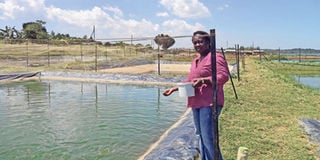This is what it takes to build a model fish farm

Rose Brockmoeller in her Mabro Fish Farm in Siaya. EVERLINE OKEWO | NATION
What you need to know:
- The farm hosts a small plant for making fish feeds, a hatchery, 32 fish ponds - liner and earthen – and 15 fish cages inside Lake Victoria. Besides, the farm conducts free trainings for farmers.
- Another merit is that the liner helps to maintain water temperature because it is black and absorbs heat.
A cold breeze that soothes the body welcomes me to Uwaria Beach along the shores of Lake Victoria in Bondo, Siaya.
The view at the lake is scenic, with the blue water stretching yonder, seemingly meeting the sky at some point.
It is on this beach that farmer Rose Brockmoeller has set up her Mabro Fish Farm. The business that sits on 10 acres is a model farm that deals with all matters fish, a much-loved delicacy in the region.
The farm hosts a small plant for making fish feeds, a hatchery, 32 fish ponds - liner and earthen – and 15 fish cages inside Lake Victoria. Besides, the farm conducts free trainings for farmers.
We find Rose supervising a group of five men mending nets used in cage fishing.
She is dressed in a blue jeans trouser and a pink blouse.
“Welcome to my fish farm,” says a bubbly Rose, who is married to a German. The two started the farm in 2011. “This is a one-stop shop for all things fish as we seek to boost farming in fish ponds in the region. You know fish ponds are not popular here because of the lake.”
With the numerous activities going on at the farm, I am lost on which venture to start with.
“Our 32 fish ponds mainly host mono-sex tilapia and catfish,” Rose offers after noticing my hesitation.
“Each pond hosts an average of 1,000 fish, and the fingerlings are in 18 hatchery tanks located inside a building to protect them from harsh temperature.”
She sells the fish when they mature in eight months to traders at Sh120 and the fingerlings go for Sh5 for tilapia and Sh7 for catfish.
GETTING THE INGREDIENTS RIGHT
At the feed making plant, there is a hammer machine, a grinder and a pelletiser, which make the section resemble a posho mill.
There are various stages one must follow when making fish feeds, which starts with getting the ingredients right.
The ingredients include wheat bran, ochong’a (fresh water shrimps), fish meal, blood meal, yam and banana leaves, maize and rice bran, among others.
These are milled in the hammer machine. The third stage is the most critical as it involves formulation. But this must start with an analysis of the ingredients. “We did ours at the Kenya Industrial Research Institute. The process takes two weeks to one month,” says Rose.
Feed formulation of the ingredients varies depending on the percentage of the crude proteins that one requires. It can be between 26 and 56 per cent.
“You need to come up with a specific percentage depending on the age and the size of the fish and fingerlings,” she advises.
The fourth stage involves adding various vitamins and minerals to the mixture. The mixture is then pelleted in the machine and dried.
Thereafter, it is packaged in 20kg bags. “We give our fish the feeds we make and sell the rest to farmers. But they are not available in agrovets because we are still following up with the Kenya Bureau of Standards for certification,” chips in Elvis Odhiambo, the general manager.
A 20kg bag of starter mash retails at Sh1,300, says Odhiambo, while the same kilo of pellets (about 4mm size) costs Sh1,500.
For training, the farm deals with groups. The farmers are trained on pond and feeds management and how to ensure they get quality fingerlings.
For pond management, for instance, water quality is paramount as it helps keeps diseases at bay.
Rose, who has been trained by the Trilateral Corporation, a partnership between Kenya, Germany and Israel, says liner ponds are better than earthen ponds.
“They are easier to maintain because water can easily be drained and clean water pumped in. Then the liner material is cleaned and disinfected,” she says, adding it costs at least Sh150,000 to make the ponds.
MAINTAIN WATER TEMPERATURE
Another merit is that the liner helps to maintain water temperature because it is black and absorbs heat.
“It is advisable to stock three fish per metre square in the pond to ensure that they have enough space to breed and grow. A pond that is 300 metres square, you will multiply 300 by 3 to get the number of fingerlings to rear, which is 900.”
Rose, a mother of two, started the business six years after quitting teaching at Nyamira Mixed Primary School in Bondo, Siaya.
With her husband they invested Sh13 million that included purchasing the land to set up the business.
“The licence for such a large agriculture enterprise averages Sh24,000. One also requires the consent of the community to put up the enterprise by convincing them that the project will benefit them.”
Authentication certificate from the Ministry of Agriculture, Livestock and Fisheries is also important for any fish farmer who wants to venture into production of fingerlings and feeds.
Her annual turnover, she says, is about Sh3 million.
“We pump the money back into the business. We have nine permanent employees and four casual workers. The business is capital intensive.”
The farmer markets her business at trade fairs and agricultural shows, and through clients who buy her products.
Her long-term goal is to turn the fish farm into a one-stop training centre for farmers and students who have interest to pursue careers in fish farming.
Kisumu County Director of Fisheries Jonam Etyang says that liner ponds are good and suitable for use in sandy soils and rocky areas.
“The liner is normally used for retaining water. You can’t use liner in clay soils because they have the ability to retain water,” says Etyang.
He noted that the government is encouraging farmers in the area to embrace ponds as fish in the lake dwindles.





